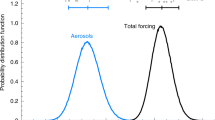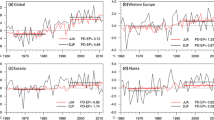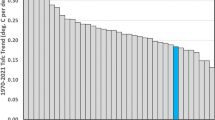Abstract
The effective radiative forcing (ERF) from the biogeophysical effects of historical land use change is quantified using the atmospheric component of the Met Office Hadley Centre Earth System model HadGEM2-ES. The global ERF at 2005 relative to 1860 (1700) is −0.4 (−0.5) Wm−2, making it the fourth most important anthropogenic driver of climate change over the historical period (1860–2005) in this model and larger than most other published values. The land use ERF is found to be dominated by increases in the land surface albedo, particularly in North America and Eurasia, and occurs most strongly in the northern hemisphere winter and spring when the effect of unmasking underlying snow, as well as increasing the amount of snow, is at its largest. Increased bare soil fraction enhances the seasonal cycle of atmospheric dust and further enhances the ERF. Clouds are shown to substantially mask the radiative effect of changes in the underlying surface albedo. Coupled atmosphere–ocean simulations forced only with time-varying historical land use change shows substantial global cooling (dT = −0.35 K by 2005) and the climate resistance (ERF/dT = 1.2 Wm−2 K−1) is consistent with the response of the model to increases in CO2 alone. The regional variation in land surface temperature change, in both fixed-SST and coupled atmosphere–ocean simulations, is found to be well correlated with the spatial pattern of the forced change in surface albedo. The forcing-response concept is found to work well for historical land use forcing—at least in our model and when the forcing is quantified by ERF. Our results suggest that land-use changes over the past century may represent a more important driver of historical climate change then previously recognised and an underappreciated source of uncertainty in global forcings and temperature trends over the historical period.









Similar content being viewed by others
References
Andrews T (2014) Using an AGCM to diagnose historical effective radiative forcing and mechanisms of recent decadal climate change. J Clim 27:1193–1209. doi:10.1175/JCLI-D-13-00336.1
Andrews T, Forster PM (2008) CO2 forcing induces semi-direct effects with consequences for climate feedback interpretations. Geophys Res Lett 35:L04802. doi:10.1029/2007GL032273
Andrews T, Gregory JM, Webb MJ, Taylor KE (2012a) Forcing, feedbacks and climate sensitivity in CMIP5 coupled atmosphere-ocean climate models. Geophys Res Lett 39:L09712. doi:10.1029/2012GL051607
Andrews T, Ringer MA, Doutriaux-Boucher M, Webb MJ (2012b) Sensitivity of an Earth system climate model to idealized radiative forcing. Geophys Res Lett 39:L10702. doi:10.1029/2012GL051942
Armstrong E, Valdes P, House J, Singarayer J (2016) The role of CO2 and dynamic vegetation on the impact of temperate land-use change in the HadCM3 coupled climate model. Earth Interact. doi:10.1175/EI-D-15-0036.1
Bellouin N, Rae J, Jones A, Johnson C, Haywood J, Boucher O (2011) Aerosol forcing in the Climate Model Intercomparison Project (CMIP5) simulations by HadGEM2-ES and the role of ammonium nitrate. J Geophys Res 116:D20206. doi:10.1029/2011JD016074
Betts RA (2000) Offset of the potential carbon sink from boreal forestation by decreases in surface albedo. Nature 408:187–190. doi:10.1038/35041545
Betts RA, Falloon PD, Goldewijk KK, Ramankutty N (2007) Biogeophysical effects of land use on climate: Model simulations of radiative forcing and large-scale temperature change. Agric For Meteorol 142:216–233
Bodas-Salcedo A, Ringer MA, Jones A (2008) Evaluation of the surface radiation budget in the atmospheric component of the hadley centre global environmental model (HadGEM1). J Clim 21:4723–4748. doi:10.1175/2008JCLI2097.1
Booth BBB, Halloran PR, Dunstone NJ, Andrews T, Bellouin N (2012) Aerosols implicated as a prime driver of twentieth-century North Atlantic climate variability. Nature 484:228–232. doi:10.1038/nature10946
Boucher O, Myhre G, Myhre A (2004) Direct human influence of irrigation on atmospheric water vapour and climate. Clim Dyn 22(6):597–603
Bright RM, Myhre G, Astrup R, Antón-Fernández C, Strømman AH (2015) Radiative forcing bias of simulated surface albedo modifications linked to forest cover changes at northern latitudes. Biogeosciences 12:2195–2205. doi:10.5194/bg-12-2195-2015
Brovkin V, Claussen M, Driesschaert E, Fichefet T, Kicklighter D, Loutre MF, Matthews HD, Ramankutty N, Schaeffer M, Sokolov A (2006) Biogeophysical effects of historical land cover changes simulated by six Earth system models of intermediate complexity. Clim Dyn 26:587–600. doi:10.1007/s00382-005-0092-6
Brovkin V, Boysen L, Arora VK, Boisier JP, Cadule P, Chini L, Claussen M, Friedlingstein P, Gayler V, van den Hurk BJJM, Hurtt GC, Jones CD, Kato E, de Noblet-Ducoudré N, Pacifico F, Pongratz J, Weiss M (2013) Effect of anthropogenic land-use and land-cover changes on climate and land carbon storage in CMIP5 projections for the twenty-first century. J Clim 26:6859–6881. doi:10.1175/JCLI-D-12-00623.1
Cesana G, Chepfer H (2012) How well do climate models simulate cloud vertical structure? A comparison between CALIPSO-GOCCP satellite observations and CMIP5 models. Geophys Res Lett 39:L20803. doi:10.1029/2012GL053153
Christidis N, Stott PA, Hegerl GC, Betts RA (2013) The role of land use change in the recent warming of daily extreme temperatures. Geophys Res Lett 40:589–594. doi:10.1002/grl.50159
Collins WJ et al (2011) Development and evaluation of an Earth-system model—HadGEM2. Geosci Model Dev 4:1051–1075. doi:10.5194/gmd-4-1051-2011
Collins WJ et al (2008) Evaluation of the HadGEM2 model. Hadley Centre Technical Note 74. http://www.metoffice.gov.uk/archive/science/climate-science/hctn74
Cox P (2001) Description of the “TRIFFID” dynamic global vegetation model. Hadley Centre Technical Note 24. www.metoffice.gov.uk/media/pdf/9/h/HCTN_24.pdf
Davies-Barnard T et al (2014) Climatic impacts of land-use change due to crop yield increases and a universal carbon tax from a scenario model. J Clim 27:1413–1424
Davin EL, de Noblet-Ducoudré N (2010) Climatic impact of global-scale deforestation: radiative versus nonradiative processes. J Clim 23:97–112. doi:10.1175/2009JCLI3102.1
Davin EL, de Noblet-Ducoudré N, Friedlingstein P (2007) Impact of land cover change on surface climate: relevance of the radiative forcing concept. Geophys Res Lett 34:L13702. doi:10.1029/2007GL029678
Forster PM, Andrews T, Good P, Gregory JM, Jackson LS, Zelinka M (2013) Evaluating adjusted forcing and model spread for historical and future scenarios in the CMIP5 generation of climate models. J Geophys Res. doi:10.1002/jgrd.50174
Gregory JM, Forster PM (2008) Transient climate response estimated from radiative forcing and observed temperature change. J Geophys Res 113:D23105. doi:10.1029/2008JD010405
Gregory JM et al (2004) A new method for diagnosing radiative forcing and climate sensitivity. Geophys Res Lett 31:L03205. doi:10.1029/2003GL018747
Hansen J et al (2005) Efficacy of climate forcings. J Geophys Res 110:D18104. doi:10.1029/2005JD005776
Hopcroft PO, Valdes PJ (2015) Last glacial maximum constraints on the Earth system model HadGEM2-ES. Clim Dyn 45:1657–1672. doi:10.1007/s00382-014-2421-0
Hopcroft PO, Valdes PJ, Woodward S, Joshi MM (2015) Last glacial maximum radiative forcing from mineral dust aerosols in an Earth system model. J Geophys Res Atmos 120:8186–8205. doi:10.1002/2015JD023742
Hurtt GC et al (2011) Harmonization of land-use scenarios for the period 1500–2100: 600 years of global gridded annual land-use transitions, wood harvest, and resulting secondary lands. Clim Change 109:17–161. doi:10.1007/s10584-011-0153-2
IPCC (2013) Annex II: climate system scenario tables. In: Stocker TF et al. (eds) Climate Change 2013: the physical science basis. Contribution of working group I to the fifth assessment report of the intergovernmental panel on climate change. Cambridge University Press, Cambridge and New York
Jones A, Haywood JM, Boucher O (2007) Aerosol forcing, climate response and climate sensitivity in the Hadley Centre climate model. J Geophys Res 112:D20211. doi:10.1029/2007JD008688
Jones CD et al (2011) The HadGEM2-ES implementation of CMIP5 centennial simulations. Geosci Model Dev 4:543–570. doi:10.5194/gmd-4-543-2011
Jones AD et al (2013) Greenhouse gas policy influences climate via direct effects of land-use change. J Clim 26:3657–3670. doi:10.1175/JCLI-D-12-00377.1
Jones GS, Stott PA, Mitchell JFB (2016) Uncertainties in the attribution of greenhouse gas warming and implications for climate prediction. J Geophys Res Atmos 121:6969–6992. doi:10.1002/2015JD024337
Kiehl JT (2007) Twentieth century climate model response and climate sensitivity. Geophys Res Lett 34:L22710. doi:10.1029/2007GL031383
Kuhlbrodt T, Gregory JM (2012) Ocean heat uptake and its consequences for the magnitude of sea level rise and climate change. Geophys Res Lett 39:L18608. doi:10.1029/2012GL052952
Lohmann U et al (2010) Total aerosol effect: radiative forcing or radiative flux perturbation? Atmos Chem Phys 10:3235–3246
Mahowald N et al (2011) Desert dust and anthropogenic aerosol interactions in the community climate system model coupled-carbon-climate model. Biogeosciences 8:387–414. doi:10.5194/bg-8-387-2011
Martin GM et al (2011) The HadGEM2 family of Met Office Unified Model Climate configurations. Geosci Model Dev 4:723–757. doi:10.5194/gmd-4-723-2011
Ming Y, Ramaswamy V (2012) Nonlocal component of radiative flux perturbation. Geophys Res Lett 39:L22706. doi:10.1029/2012GL054050
Morice CP, Kennedy JJ, Rayner NA, Jones PD (2012) Quantifying uncertainties in global and regional temperature change using an ensemble of observational estimates: the HadCRUT4 data set. J Geophys Res 117:D08101. doi:10.1029/2011JD017187
Myhre G et al (2013) Anthropogenic and natural radiative forcing. In: Stocker TF et al. (eds) Climate change 2013: the physical science basis. Contribution of working group I to the fifth assessment report of the intergovernmental panel on climate change. Cambridge University Press, Cambridge and New York
Noblet-Ducoudré ND, Boisier J-P, Pitman A, Bonan GB, Brovkin V, Faye C, Delire C, Gayler V, van den Hurk BJJM, Lawrence PJ, van der Molen MK, Müller C, Reick CH, Strengers BJ, Voldoire A (2012) Determining robust impacts of land-use-induced land cover changes on surface climate over North America and Eurasia: results from the first set of LUCID experiments. J Clim 25:3261–3281. doi:10.1175/JCLI-D-11-00338.1
Pitman AJ et al (2009) Uncertainties in climate responses to past land cover change: first results from the LUCID intercomparison study. Geophys Res Lett 36:L14814. doi:10.1029/2009GL039076
Pitman AJ, Avila FB, Abramowitz G, Wang YP, Phipps SJ, de Noblet-Ducoudré N (2011) Importance of background climate in determining impact of land-cover change on regional climate. Nat Clim Change 1:472–475. doi:10.1038/nclimate1294
Pongratz J, Raddatz T, Reick CH, Esch M, Claussen M (2009) Radiative forcing from anthropogenic land cover change since A.D. 800. Geophys Res Lett 36:L02709. doi:10.1029/2008GL036394
Pongratz J, Reick CH, Raddatz T, Claussen M (2010) Biogeophysical versus biogeochemical climate response to historical anthropogenic land cover change. Geophys Res Lett 37:L08702. doi:10.1029/2010GL043010
Pongratz J, Reick CH, Houghton RA, House JI (2014) Terminology as a key uncertainty in net land use and land cover change carbon flux estimates. Earth Syst Dyn 5:177–195. doi:10.5194/esd-5-177-2014
Rotstayn LD, Penner JE (2001) Indirect aerosol forcing, quasi forcing, and climate response. J Clim 14:2960–2975
Sherwood SC, Bony S, Boucher O, Bretherton C, Forster PM, Gregory JM, Stevens B (2015) Adjustments in the forcing-feedback framework for understanding climate change. Bull Am Meteorol Soc 96:217–228. doi:10.1175/BAMS-D-13-00167.1
Shine KP, Cook J, Highwood EJ, Joshi MJ (2003) An alternative to radiative forcing for estimating the relative importance of climate change mechanisms. Geophys Res Lett 30(20):2047. doi:10.1029/2003GL018141
Sitch S, Brovkin V, von Bloh W, van Vuuren D, Eickhout B, Ganopolski A (2005) Impacts of future land cover changes on atmospheric CO2 and climate. Global Biogeochem Cycles 19:GB2013. doi:10.1029/2004GB002311
Soden BJ, Held IM (2006) An assessment of climate feedbacks in coupled ocean-atmosphere models. J Clim 19:3354–3360. doi:10.1175/JCLI3799.1
Stott PA, Jones GS (2012) Observed 21st century temperatures further constrain likely rates of future warming. Atmos Sci Lett 13:151–156. doi:10.1002/asl.383
Taylor KE, Crucifix M, Braconnot P, Hewitt CD, Doutriaux C, Broccoli AJ, Mitchell JFB, Webb MJ (2007) Estimating shortwave radiative forcing and response in climate models. J Clim 20:2530–2543. doi:10.1175/JCLI4143.1
Taylor KE, Stouffer RJ, Meehl GA (2011) An overview of CMIP5 and the experiment design. Am Meteorol Soc, Bull. doi:10.1175/BAMS-D-11-00094.1
Wild M et al (2015) The energy balance over land and oceans: an assessment based on direct observations and CMIP5 climate models. Clim Dyn 44:3393–3429. doi:10.1007/s00382-014-2430-z
Woodward S (2001) Modeling the atmospheric life cycle and radiative impact of mineral dust in the Hadley Centre climate model. J Geophys Res 106(D16):18155–18166. doi:10.1029/2000JD900795
Woodward S (2011) Mineral dust in HadGEM2. Hadley Centre Technical Note 87. http://www.metoffice.gov.uk/archive/science/climate-science/hctn87
Zelinka MD, Andrews T, Forster PM, Taylor KE (2014) Quantifying components of aerosol-cloud-radiation interactions in climate models. J Geophys Res 119:7599–7615. doi:10.1002/2014JD021710
Acknowledgments
We thank John Hughes, Nikos Christidis and Fraser Lott for HadGEM2-ES historical simulations. This work was supported by the Joint UK DECC/Defra Met Office Hadley Centre Climate Programme (GA01101). C.D.J. was also supported by the European Commission’s 7th Framework Program Grant Agreement 282672 (EMBRACE). We thank two anonymous reviewers for positive and constructive comments that helped to improve the clarity of the manuscript. We acknowledge the World Climate Research Programme’s Working Group on Coupled Modelling, which is responsible for CMIP, and we thank the climate modeling groups for producing and making available their model output. For CMIP the U.S. Department of Energy’s Program for Climate Model Diagnosis and Intercomparison provides coordinating support and led development of software infrastructure in partnership with the Global Organization for Earth System Science Portals.
Author information
Authors and Affiliations
Corresponding author
Rights and permissions
About this article
Cite this article
Andrews, T., Betts, R.A., Booth, B.B.B. et al. Effective radiative forcing from historical land use change. Clim Dyn 48, 3489–3505 (2017). https://doi.org/10.1007/s00382-016-3280-7
Received:
Accepted:
Published:
Issue Date:
DOI: https://doi.org/10.1007/s00382-016-3280-7




